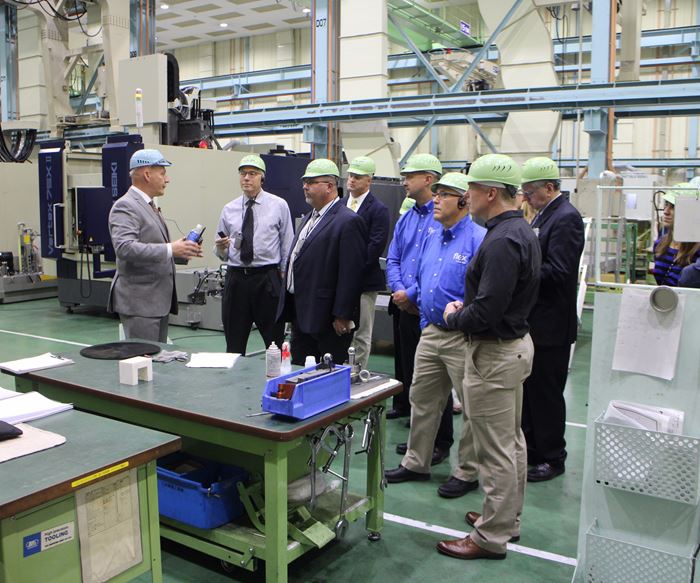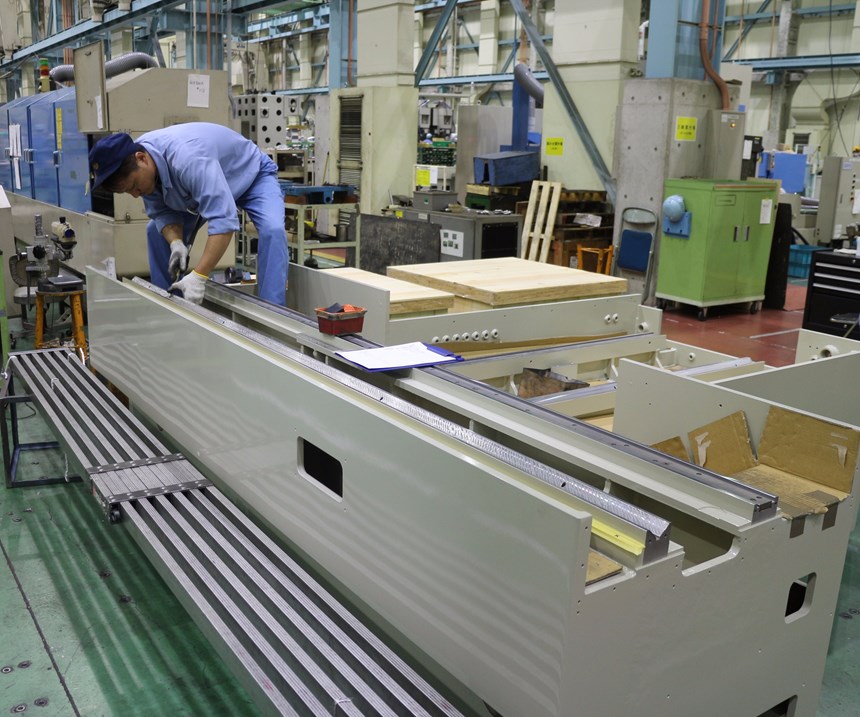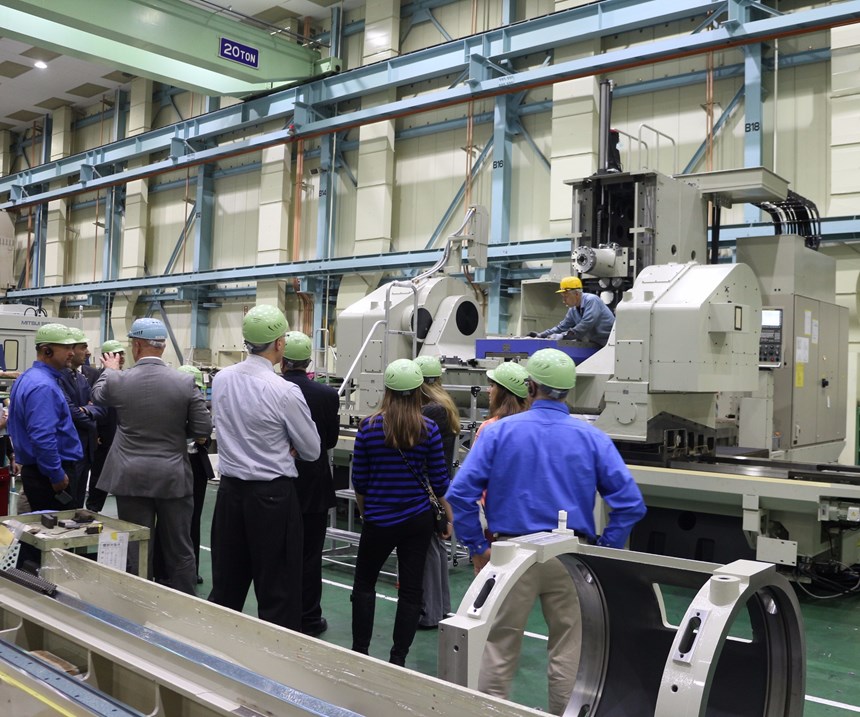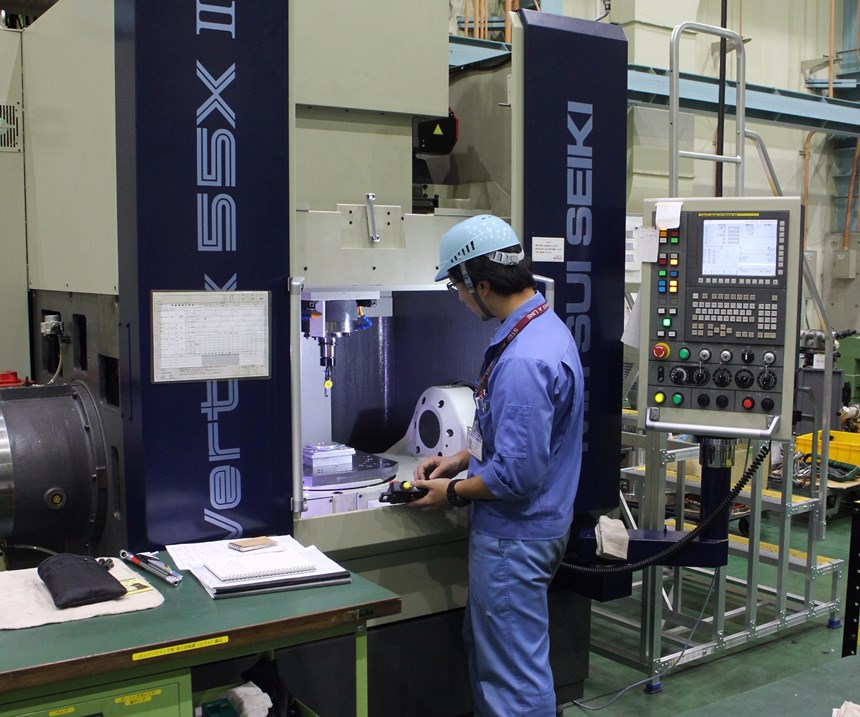Precision and Custom Solutions Showcased at Mitsui Seiki
A tour of the company’s factory in Japan highlighted the accuracy of its machine tools as well as their adaptability for specific applications.
Share


Takumi USA
Featured Content
View More
Hwacheon Machinery America, Inc.
Featured Content
View More





When “chasing microns” in a machining application, it is critical to manage each part of the process, right down to the heat generated in machine tool components, says Robb Hudson, CEO of Mitsui Seiki (U.S.A.) Inc. Mr. Hudson was speaking specifically about maintaining tolerances in a specialized turning operation on one of the company’s milling machines, but “chasing microns” is an apt description of how the machine tool builder operates. Production is a painstaking process that still relies on a significant amount of manual work and skill to build machine tools that can hold tolerances approaching the single-digit micron range. On an October trip to Mitsui Seiki’s Japan headquarters and machine tool factory, I—along with a group of customers and other media representatives—got a close look at this hand-crafted method of machine tool production and where this approach is taking the company.
Mitsui Seiki provides jig and bore grinding machines, thread grinding machines, vertical machining centers (VMCs) and horizontal machining centers (HMCs) intended for high-precision applications. Within Japan, its largest market is automotive, thanks in part to an ongoing relationship with Toyota Motors. Internationally, however, 77 percent of sales go to the aerospace industry, especially in North America, and die/mold is a growing area of interest as the industry demands higher-tolerance, longer-lasting molds. Lead times on its machine tools can be lengthy; six to seven months for a Vertex VMC, or up to a year for larger machine tools. But there is a distinct advantage from Mitsui Seiki’s style of on-demand machine tool manufacturing for those that require a highly accurate solution for a specialized problem. The company works closely with customers as well as partners like FANUC to customize machine tools specifically for the user’s application.
The level of control exercised in the manufacturing process results in machine tools with positioning accuracy within 1 micron, and the ability to identify a tool center point within less than 25 microns throughout the entire cube (down to 15 or 16 microns on some machines). As Mr. Hudson explained during the visit, the company is close to achieving coordinate measuring machine (CMM)-level accuracy in its machine tools, made possible through several distinguishing factors:
- A stable production environment. The machine tool factory, located on the Mitsui Seiki campus in Kawajima, Japan, occupies a building of about 600,000 square feet that is designed from the ground up to support the manufacture of highly accurate machine tools. The foundation of the production floor is a layer of 1-meter-thick concrete sitting on top of 1,700 pylons that extend more than 100 feet into the ground to the bedrock. The foundation that supports the exoskeleton of the building, including its high-capacity overhead cranes, is separate from this foundation, to prevent the transfer of vibration. The temperature of the building is carefully controlled to 23°C ±0.5° (about 74°F), and a specialized air-circulation system keeps the temperature constant throughout.
- A vertically integrated operation, with many components made or assembled in house. These include some Meehanite castings (used for their vibration damping properties), many ballscrews and guideways, and 90 percent of the spindles used in Mitsui Seiki machine tools. Some of this production, such as hobbing of brass gears for tables, rotaries and trunnions, is performed on-site in the machine tool factory, while other operations take place in other Mitsui Seiki facilities. By controlling the individual components, the company finds it can better control the final quality of its machine tools.
- Hand-scraped surfaces. Every machine that Mitsui Seiki makes undergoes a hand scraping process to ensure the fit of its mating surfaces and straightness of travel. In a highly skilled manual process, a technician must rough and finish-scrape critical surfaces on the machine tool bed, removing miniscule amounts of material to create hatches across the surface.
After each pass, the technician takes readings with a collimator using a target placed every 100 mm, graphing the results by hand and using these readings to inform the next pass. The technician is looking for pitch, roll and yaw along the surface—not just straightness, says Scott Walker, chairman of Mitsui Seiki (U.S.A) Inc. The goal is not to scrape the surface flat, but to scrape it to a condition that will enable the machine tool to remain flat no matter where it is positioned. A large linear bed, for instance, will be scraped with a slight dip to account for the weight of the machine when it reaches the far edges of its travels, Mr. Walker says.
Mitsui Seiki machine tools and many of the spindles, rotary tables, ballscrews and other critical components are assembled in the Kawajima factory, while some are sourced from other company facilities. For components in which the machine tool builder does not specialize, it turns to the expertise of partners such as FANUC, the provider of Mitsui Seiki’s servomotors and controls. A close relationship between the two Japanese companies enables Mitsui Seiki to provide machine tools that are automation-ready and to make extensive adjustments where necessary to suit customer needs.
One such example of a customized solution showcased during the trip was based on Mitsui Seiki’s Vertex 55X VMC platform. Popular in the aerospace and die/mold industries, the VMC is already a versatile machine tool. It can provide three or five axes, with direct-drive motors in A and C for high accuracy. Direct-drive spindles manufactured by Mitsui Seiki are available for speeds ranging from 15,000 to 30,000 rpm, while 50,000- to 75,000-rpm spindles are offered through a partnership with a spindle manufacturer. The Vertex 55X can be configured with a FANUC robot for automation, and a number of options for tool changers, coolant filtration and more are available.
But when a customer needed a specialized configuration to support its machining of titanium aluminide blades for an aerospace application, Mitsui Seiki obliged. The builder modified the machine’s internal layout, rotating the trunnion 90 degrees to sit perpendicular to the door and leave space for sequential fixturing. The company also worked with FANUC to optimize the VMC’s servomotors and implement dynamic tuning to adjust to the weight changes of the workpiece. That customer—a Japanese manufacturer called AeroEdge—currently has 25 of these specialized Vertex VMCs in operation.
Standard machine tool offerings are expanding as well. Development continues on Mitsui Seiki’s hybrid manufacturing platform that combines laser deposition additive manufacturing with Vertex five-axis machining capability, as well as on the Blue Arc machining platform, which utilizes a high-speed erosion process. This past year at the Japan International Machine Tool Fair (JIMTOF), the company introduced the PJ 812 vertical jig boring machine for the die/mold industry, a three-axis machine offering submicron accuracy in the X, Y and Z axes.
Alongside platform development, Mitsui Seiki is also focused on integrating “fully automated adaptive processing,” a concept that employs a loop between machine tool and CMM for in-process measurement. A workpiece could be measured on a CMM before machining and then quickly located on the machine tool, with the tool path adapting to the current workpiece location and its condition based on the CMM data. This approach could improve process reliability and reduce post-inspection measurement. The capability is currently in testing, but could be available on the Vertex platform as early as next year.
Related Content
Lean Approach to Automated Machine Tending Delivers Quicker Paths to Success
Almost any shop can automate at least some of its production, even in low-volume, high-mix applications. The key to getting started is finding the simplest solutions that fit your requirements. It helps to work with an automation partner that understands your needs.
Read MoreDN Solutions' VMC Provides Diverse Five-Axis Machining
The company’s DVF Series comprises compact five-axis CNC machines that are designed for diverse five-sided or simultaneous five-axis applications.
Read MoreFANUC Details Robotic Vision, ROBODRILLS and More at IMTS 2024
FANUC’s IMTS 2024 booth includes real-time demonstrations that show the abilities of its equipment, including robots, controllers and machine tools.
Read MoreFryer Milling Machine Provides Fast Setup, Simple Programming
The MB-R toolroom bed mill is reportedly capable of single- or multi-part production with a 0.0002" accuracy.
Read MoreRead Next
Registration Now Open for the Precision Machining Technology Show (PMTS) 2025
The precision machining industry’s premier event returns to Cleveland, OH, April 1-3.
Read More5 Rules of Thumb for Buying CNC Machine Tools
Use these tips to carefully plan your machine tool purchases and to avoid regretting your decision later.
Read MoreBuilding Out a Foundation for Student Machinists
Autodesk and Haas have teamed up to produce an introductory course for students that covers the basics of CAD, CAM and CNC while providing them with a portfolio part.
Read More
.jpg;width=70;height=70;mode=crop)



































.jpg;maxWidth=300;quality=90)



















